Monday, December 11, 2006
Bohemia
Visiting the Czech Republic wasn’t necessarily on the top of my list of things to do and places to visit, but when the USO offered an express trip to Prague, I jumped at the chance to go, and I'm so glad that I did. The bonus was that our tour escort and guide was from there, so that added to our experience. Prague, or Praha, is the capital of the Czech Republic and is known as the pearl of Europe for its beauty.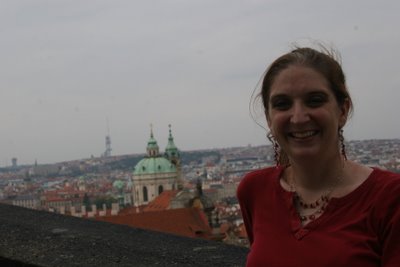
This is the neoclassical Czech National Museum with a statue of Saint Wenceslas, a 9th century duke in the foreground. He was the first patron of the country and is represented on the 20-koruna coins.
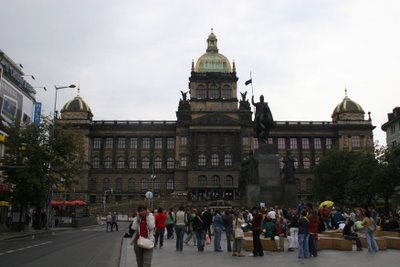
One thing that really struck me was the sheer size of the buildings. They are huge! Many of them are very colorful as well. Someone speculated that everything was very drab when its citizens lived under the Iron Curtain, so when it fell, the colors came out. I believe it!
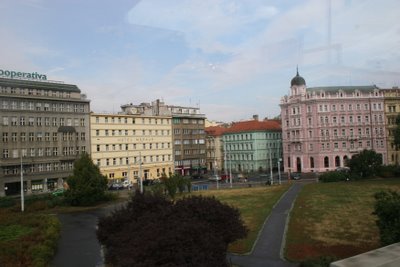
The streets in the shopping district were interesting as well. They were slightly curved...just enough that I couldn’t see to the end of the street, but not enough so I felt like I was walking in circles. Very interesting.
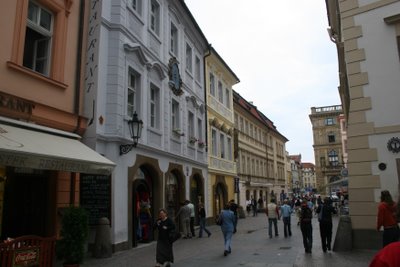
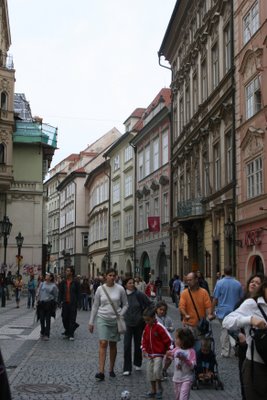 Rather than numbering the houses and buildings, each one had a unique design on them to distinguish them. This was particularly helpful centuries ago when people couldn’t read. The house below is the house of five crowns, where our tour escort/guide’s mother was born.
Rather than numbering the houses and buildings, each one had a unique design on them to distinguish them. This was particularly helpful centuries ago when people couldn’t read. The house below is the house of five crowns, where our tour escort/guide’s mother was born.
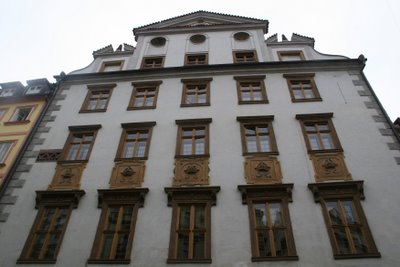
Many of the buildings were rather ornately painted and decorated. It is a very beautiful city.
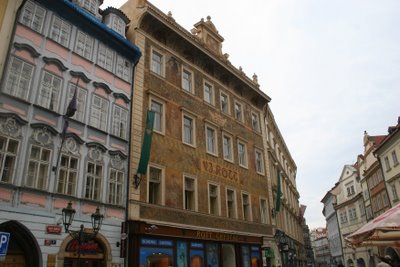
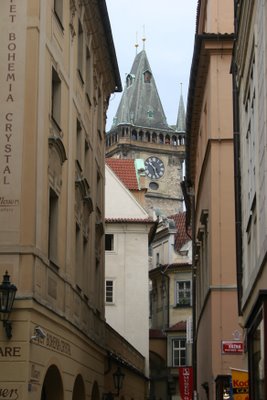 This was my first glimpse of the clock tower with the 14th century Gothic style astronomical clock (further below on the tower) in the heart of downtown Prague. The photo below is of the four buildings to the left of it. The red building is the Town Hall (which our guide referred to as the “marriage hall”), with the Prague coat of arms displayed across the top. Every couple who gets married in Prague must visit here. We actually saw a bride and groom walking there to register their marriage. Very neat (but, alas, they were just out of range for me to get a decent photo). The old Town Hall was constructed in 1338, when king John of Luxembourg granted the city a royal charter. In the following centuries, due to the city's growth, some of the neighboring houses were added to the Town Hall building.
This was my first glimpse of the clock tower with the 14th century Gothic style astronomical clock (further below on the tower) in the heart of downtown Prague. The photo below is of the four buildings to the left of it. The red building is the Town Hall (which our guide referred to as the “marriage hall”), with the Prague coat of arms displayed across the top. Every couple who gets married in Prague must visit here. We actually saw a bride and groom walking there to register their marriage. Very neat (but, alas, they were just out of range for me to get a decent photo). The old Town Hall was constructed in 1338, when king John of Luxembourg granted the city a royal charter. In the following centuries, due to the city's growth, some of the neighboring houses were added to the Town Hall building.
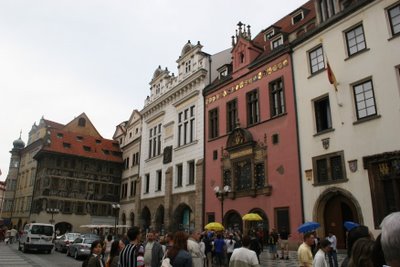
This is the detail of the Renaissance building on the far left. What’s interesting about this building is that it was painted first with a coat of white paint, then with a coat of black over it. The designs on the building were created by etching the black paint away to reveal the white underneath. I thought the detail and the shading of this artwork was absolutely amazing!
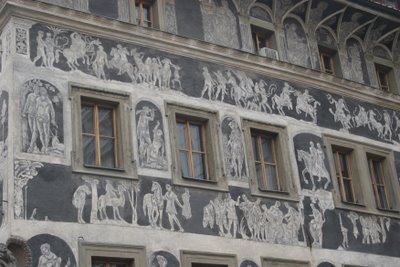
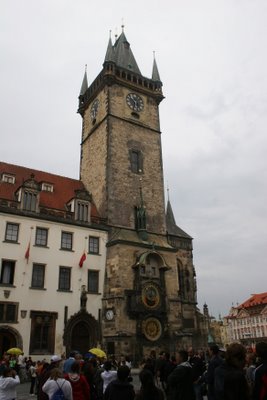 Here’s another view of the astronomical clock -- one of the most famous sights in the city. This is actually a copy of the original 'Orloj' (clock), which dates from 1410. It chimes on the hour from 8 a.m. to 8 p.m. and comes to life. The 12 apostles' figurines hidden inside the tower reveal themselves and move past the two small windows of the clock. The astronomical clock just below the windows represents the medieval perception of the universe to measures hours, moon and sun movements, and the 12 zodiac symbols displayed in the clock are surrounded by typical rural figures of the time.
Here’s another view of the astronomical clock -- one of the most famous sights in the city. This is actually a copy of the original 'Orloj' (clock), which dates from 1410. It chimes on the hour from 8 a.m. to 8 p.m. and comes to life. The 12 apostles' figurines hidden inside the tower reveal themselves and move past the two small windows of the clock. The astronomical clock just below the windows represents the medieval perception of the universe to measures hours, moon and sun movements, and the 12 zodiac symbols displayed in the clock are surrounded by typical rural figures of the time.
The photo below is of the courtyard in the downtown square...just to the right of the astronomical clock.
 At left is a 14th-15th century Gothic church near the Town Hall. At right is the city’s oldest church...also near the Town Hall.
At left is a 14th-15th century Gothic church near the Town Hall. At right is the city’s oldest church...also near the Town Hall.
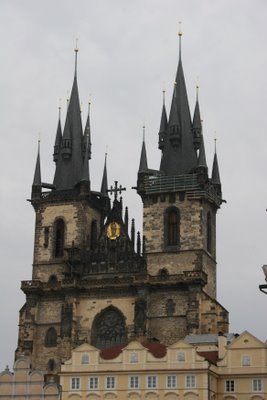
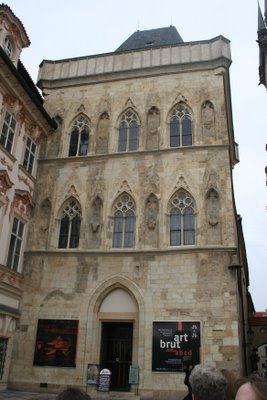
Toward the end of our walking tour, we headed toward the Vltava River and caught our first glimpse of Prazsky Hrad, the Prague Castle (left). Our tour ended at this bridge adorned with beautiful, massive statues. As we walked across, we had the option of shopping from a variety of street vendors as well as delighting in the performances of a few musicians. There was one group that even had copies of its CD for sale!
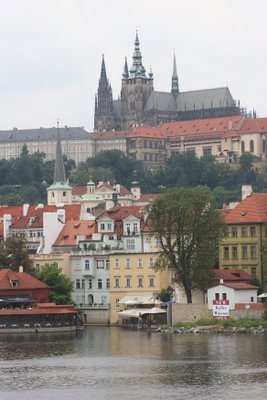
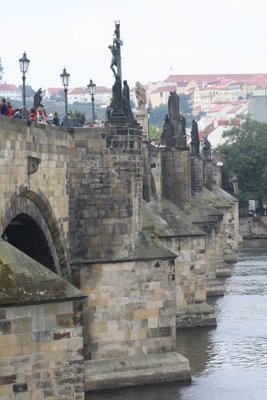
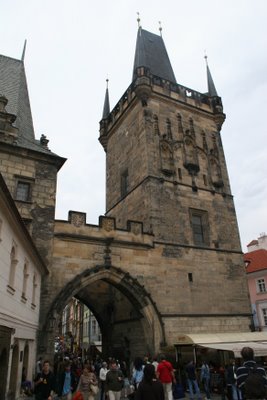 This was the tower that welcomed us on the other side of the bridge.
This was the tower that welcomed us on the other side of the bridge.
After climbing up a winding street and seeing a magnificent view of the city and river below (see the top photo of me), we made it to the castle where massive statues and guards were keeping watch. The guards didn’t have the same flair as the Queen's Guard at Buckingham Palace has, but they were still impressive nonetheless.
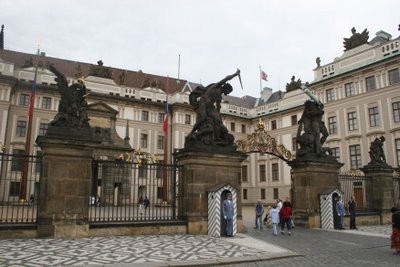
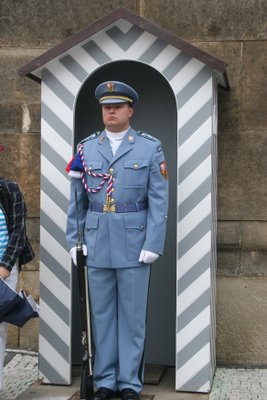 After we walked through the gate and into the next open courtyard, we saw the St. Vitus Cathedral. St. Wenceslas Chapel is an interesting area of St. Vitus Cathedral, since it holds the remains of the patron saint of Bohemia, St. Wenceslas. His silver tomb is very tall and ornate. In fact, it’s so large that it consumes most of the aisle on the one side of the cathedral…visitors have to pass single file.
After we walked through the gate and into the next open courtyard, we saw the St. Vitus Cathedral. St. Wenceslas Chapel is an interesting area of St. Vitus Cathedral, since it holds the remains of the patron saint of Bohemia, St. Wenceslas. His silver tomb is very tall and ornate. In fact, it’s so large that it consumes most of the aisle on the one side of the cathedral…visitors have to pass single file.
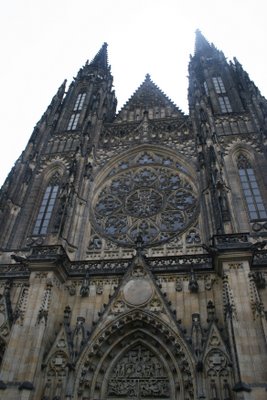
I was impressed by the artwork detail on the outside of the cathedral…such vivid colors and details.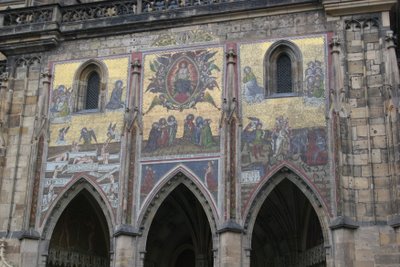 The cathedral itself was also massive. It seemed to go on and on as we walked around it!
The cathedral itself was also massive. It seemed to go on and on as we walked around it!

The grounds also held the remnants of the Church of the Virgin Mary. This was the oldest church at Prague Castle and the second-oldest in Bohemia. It was built between 882 and 884 at the express wish of Prince Borivoj I and became the burial place of Prince Spytihnev I and his wife who died in 915 and 918. It was rebuilt in the 11th century, but was later destroyed by fire in the 13th century. This is what remains of the church.
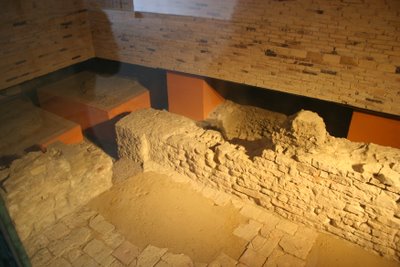
One last interesting thing I noticed throughout the city was its manhole covers. I enjoyed the uniqueness of the design that adorned the streets. Very interesting and fitting to the city.
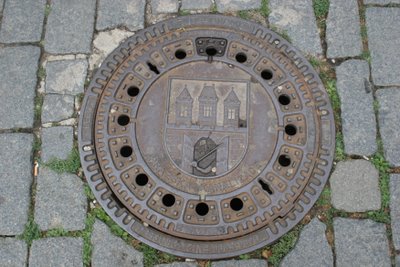

This is the neoclassical Czech National Museum with a statue of Saint Wenceslas, a 9th century duke in the foreground. He was the first patron of the country and is represented on the 20-koruna coins.

One thing that really struck me was the sheer size of the buildings. They are huge! Many of them are very colorful as well. Someone speculated that everything was very drab when its citizens lived under the Iron Curtain, so when it fell, the colors came out. I believe it!

The streets in the shopping district were interesting as well. They were slightly curved...just enough that I couldn’t see to the end of the street, but not enough so I felt like I was walking in circles. Very interesting.

 Rather than numbering the houses and buildings, each one had a unique design on them to distinguish them. This was particularly helpful centuries ago when people couldn’t read. The house below is the house of five crowns, where our tour escort/guide’s mother was born.
Rather than numbering the houses and buildings, each one had a unique design on them to distinguish them. This was particularly helpful centuries ago when people couldn’t read. The house below is the house of five crowns, where our tour escort/guide’s mother was born.
Many of the buildings were rather ornately painted and decorated. It is a very beautiful city.

 This was my first glimpse of the clock tower with the 14th century Gothic style astronomical clock (further below on the tower) in the heart of downtown Prague. The photo below is of the four buildings to the left of it. The red building is the Town Hall (which our guide referred to as the “marriage hall”), with the Prague coat of arms displayed across the top. Every couple who gets married in Prague must visit here. We actually saw a bride and groom walking there to register their marriage. Very neat (but, alas, they were just out of range for me to get a decent photo). The old Town Hall was constructed in 1338, when king John of Luxembourg granted the city a royal charter. In the following centuries, due to the city's growth, some of the neighboring houses were added to the Town Hall building.
This was my first glimpse of the clock tower with the 14th century Gothic style astronomical clock (further below on the tower) in the heart of downtown Prague. The photo below is of the four buildings to the left of it. The red building is the Town Hall (which our guide referred to as the “marriage hall”), with the Prague coat of arms displayed across the top. Every couple who gets married in Prague must visit here. We actually saw a bride and groom walking there to register their marriage. Very neat (but, alas, they were just out of range for me to get a decent photo). The old Town Hall was constructed in 1338, when king John of Luxembourg granted the city a royal charter. In the following centuries, due to the city's growth, some of the neighboring houses were added to the Town Hall building.
This is the detail of the Renaissance building on the far left. What’s interesting about this building is that it was painted first with a coat of white paint, then with a coat of black over it. The designs on the building were created by etching the black paint away to reveal the white underneath. I thought the detail and the shading of this artwork was absolutely amazing!

 Here’s another view of the astronomical clock -- one of the most famous sights in the city. This is actually a copy of the original 'Orloj' (clock), which dates from 1410. It chimes on the hour from 8 a.m. to 8 p.m. and comes to life. The 12 apostles' figurines hidden inside the tower reveal themselves and move past the two small windows of the clock. The astronomical clock just below the windows represents the medieval perception of the universe to measures hours, moon and sun movements, and the 12 zodiac symbols displayed in the clock are surrounded by typical rural figures of the time.
Here’s another view of the astronomical clock -- one of the most famous sights in the city. This is actually a copy of the original 'Orloj' (clock), which dates from 1410. It chimes on the hour from 8 a.m. to 8 p.m. and comes to life. The 12 apostles' figurines hidden inside the tower reveal themselves and move past the two small windows of the clock. The astronomical clock just below the windows represents the medieval perception of the universe to measures hours, moon and sun movements, and the 12 zodiac symbols displayed in the clock are surrounded by typical rural figures of the time.The photo below is of the courtyard in the downtown square...just to the right of the astronomical clock.
 At left is a 14th-15th century Gothic church near the Town Hall. At right is the city’s oldest church...also near the Town Hall.
At left is a 14th-15th century Gothic church near the Town Hall. At right is the city’s oldest church...also near the Town Hall.

Toward the end of our walking tour, we headed toward the Vltava River and caught our first glimpse of Prazsky Hrad, the Prague Castle (left). Our tour ended at this bridge adorned with beautiful, massive statues. As we walked across, we had the option of shopping from a variety of street vendors as well as delighting in the performances of a few musicians. There was one group that even had copies of its CD for sale!


 This was the tower that welcomed us on the other side of the bridge.
This was the tower that welcomed us on the other side of the bridge.After climbing up a winding street and seeing a magnificent view of the city and river below (see the top photo of me), we made it to the castle where massive statues and guards were keeping watch. The guards didn’t have the same flair as the Queen's Guard at Buckingham Palace has, but they were still impressive nonetheless.

 After we walked through the gate and into the next open courtyard, we saw the St. Vitus Cathedral. St. Wenceslas Chapel is an interesting area of St. Vitus Cathedral, since it holds the remains of the patron saint of Bohemia, St. Wenceslas. His silver tomb is very tall and ornate. In fact, it’s so large that it consumes most of the aisle on the one side of the cathedral…visitors have to pass single file.
After we walked through the gate and into the next open courtyard, we saw the St. Vitus Cathedral. St. Wenceslas Chapel is an interesting area of St. Vitus Cathedral, since it holds the remains of the patron saint of Bohemia, St. Wenceslas. His silver tomb is very tall and ornate. In fact, it’s so large that it consumes most of the aisle on the one side of the cathedral…visitors have to pass single file.
I was impressed by the artwork detail on the outside of the cathedral…such vivid colors and details.
 The cathedral itself was also massive. It seemed to go on and on as we walked around it!
The cathedral itself was also massive. It seemed to go on and on as we walked around it!
The grounds also held the remnants of the Church of the Virgin Mary. This was the oldest church at Prague Castle and the second-oldest in Bohemia. It was built between 882 and 884 at the express wish of Prince Borivoj I and became the burial place of Prince Spytihnev I and his wife who died in 915 and 918. It was rebuilt in the 11th century, but was later destroyed by fire in the 13th century. This is what remains of the church.

One last interesting thing I noticed throughout the city was its manhole covers. I enjoyed the uniqueness of the design that adorned the streets. Very interesting and fitting to the city.

Labels: Czech Republic, Travel
